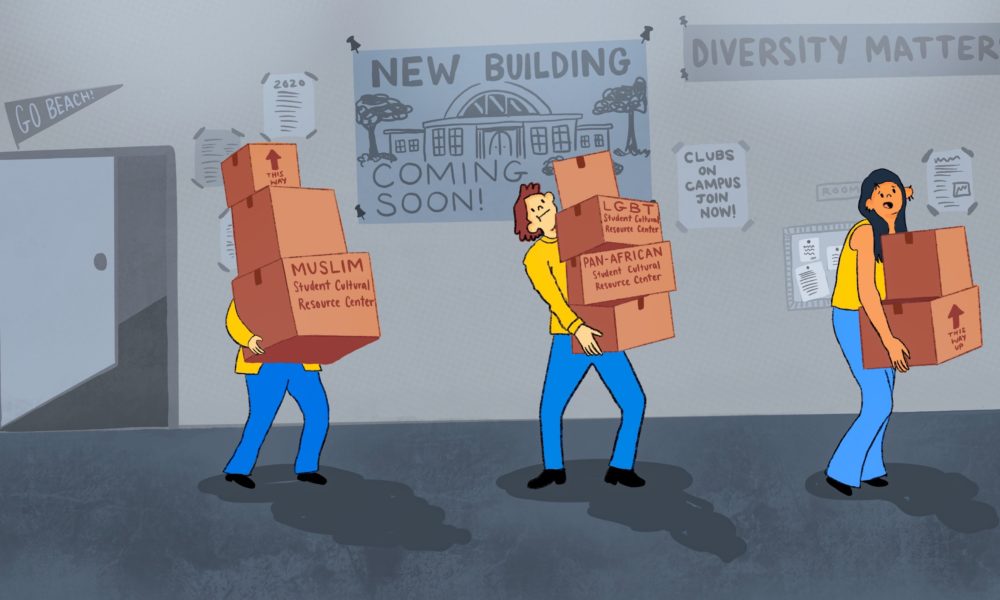Students and faculty that reside in Faculty Office Building-4, Faculty Office Building-5 and Peterson Hall have expressed growing concerns over their upcoming relocation as the university plans to replace those buildings with a 130,000-square-foot structure for the College of Health and Human Services.
The PH-1 Replacement Building Project remains in limbo, however, pending the passing of Proposition 13, a proposed $15 billion California schools construction bond. The proposition is not expected to pass with a current 55% count of voters against it.
There are a few different plans the university is considering for the relocation project.
- The first would relocate organizations from FO-5 and PH-1 into the new HHS building.
- The second would relocate groups from FO-4 to the Horn Center. A new parking lot to accommodate the new facility would then take the place of FO-4.
“I know my first year, I was just like, ‘Wow, I’m just a number here, I’m my ID number, and that’s all I’m ever gonna be to this school,’” said Anais Rocha, a fourth-year international studies major. “A lot of times, that’s what all of us feel until we find our own community, and then to be scared of it being taken away is really heartbreaking.”
Rocha is a member of La Raza Student Association, a social, cultural and political organization based in FO-4 which strives to build community among Latinx students.
“It becomes really important because this is where you form lifetime relationships with people,” Rocha said. “I know this happens in all the centers, I’m not just speaking for La Raza.”
Initial reports and emails to the cultural centers spoke only about the building being torn down and didn’t mention any other plans for relocation. Without any context regarding the future of their centers, members of the organizations feared the worst.
“We reached out to alumni and started building our network to see how we were going to tackle this issue,” Rocha said. “It was just really disheartening because we didn’t know that this was actually something that was going to happen.”
Gered Jones, a first-year communications major, is a member of the Asian American and Pacific Islander Student Cultural Resource Center and said he too doesn’t know where the association will end up.
“The only thing I was told [was] that this whole building would be demolished for construction; they haven’t really explained where we’re gonna go,” Jones said.
Mark Zakhour, director of design and construction services, said that the concern is most likely a case of miscommunication.
“They won’t be left without a home,” Zakhour said. “I think it’s people getting excited because they don’t have the information, or they’re getting ahead of things and making assumptions that aren’t necessarily right.”
Zakhour did recognize that students’ concerns were valid and understandable.
“They have all rights to be up in arms if they want to be, but the truth of the matter is we haven’t really started communicating – we haven’t started a full strategy because we don’t even know if we have a project,” he said.
Michael Gardner, director of campus planning and sustainability, said the issue at hand isn’t anything new.
“People move around on campus, you know, it happens,” Gardner said. “If there’s a current occupant of a building and we take their building down, they’re going to get a new place.”
The campus Space Committee looks at all the needs of the campus and then develops priorities for who goes where whenever a space vacates.
Backfill space will be located in newer, more permanent buildings and will be freshly remodeled. Rooms in FO-4, FO-5 and PH-1 currently face various seismic, accessibility and maintenance problems.
“In my vision, in the campus plan, they would all be together sharing one nice space somewhere,” Gardner said.
Zakhour said that the university will utilize backfill space – classrooms vacated through a move to a different facility – to house the cultural centers down the line when officials schedule FO-4 to be demolished.
Eliana Touch, a first-year pre-psych major, said that she’d prefer the centers to be moved to a more central location, such as the University Student Union.
“This is where I go all the time, it’s so important to us that we have these resources,” Touch said. “If we are going to have a different setting, in terms of where we are going to move, I hope that it’s more accessible, for not just the AAPI room, but also for all the other cultural centers, as well.”
Jones said that whatever the outcome is, he’s just happy they’ll have a home.
“As long as they’re not throwing us in a janitor’s closet, we would probably be OK,” Jones said. “But, in the future, obviously for all the clubs, it should be somewhere permanent.”
Travis Tamasese, chief of staff for student affairs, said in an email that discussions were held last fall to hold focus groups at the Student Cultural Resource Board meeting.
Tamasese and John Hamilton, assistant vice president of university access and retention, will be heading up those focus groups in March and April.
“Ultimately, the students who utilize the centers remain a high priority for us,” Tamasese said. “We understand that the centers play a unique role in the reflections of their heritage and identities, and we are committed to working together to find [a] resolution.”




